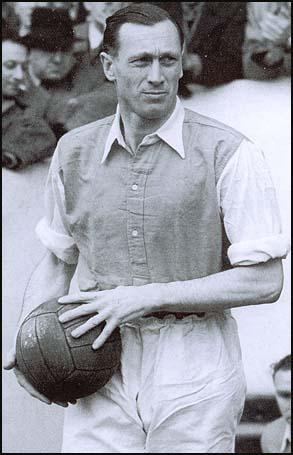On this day on 9th August
On this day in 1757 engineer Thomas Telford, the son of a shepherd, was born in Westerkirk, Scotland. At the age of 14 he was apprenticed to a stonemason. He worked for a time in Edinburgh and in 1792 he moved to London where he was involved in building additions to Somerset House. Two years later he found work at Portsmouth dockyard.
In 1787 he became surveyor of public works for Shropshire. By this time Telford had established a good reputation as an engineer and in 1790 was given the task of building a bridge over the River Severn at Montford. This was followed by a canal that linked the ironworks and collieries of Wrexham with Chester and Shrewsbury. This involved building an aqueduct over the River Dee. On the Pontcysyllte Aqueduct, Telford used a new method of construction consisting of troughs made from cast-iron plates and fixed in masonry.
After the completion of the Ellesmere Canal Telford moved back to Scotland where he took control of the building of Caledonian Canal. Other works by Telford include the Menai Suspension Bridge (1819-1826) and the Katherine's Docks (1824-1828) in London.
Telford was also an important road builder. He was responsible for rebuilding the Shrewsbury to Holyhead road and the North Wales coast road between Chester and Bangor. During his life Telford built more than 1,000 miles of road, including the main road between London and Holyhead.
Thomas Telford died on 2nd September 1834.
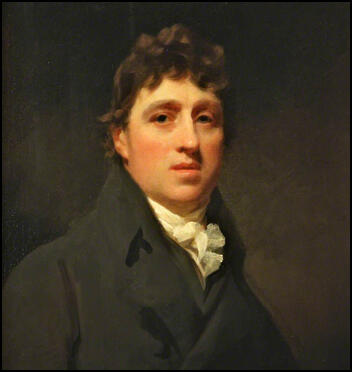
On this day in 1867 Evelina Scarlett, the youngest daughter of William Frederick Scarlett, the 3rd Lord Arbinger, was was born at Inverlochy Castle.
Evelina married Major Henry Haverfield in 1887 when she was 19. He was 20 years her senior. They moved to Dorset and over the next few years she had two sons.
Henry Haverfield died in 1895. She remarried another soldier, Major John Blaguy, in July 1899, but reassumed the name "Haverfield" by deed poll within a month of the marriage. An excellent horsewomen, she accompanied her new husband husband to South Africa when he fought in the Boer War.
An early member of the National Union of Suffrage Societies she joined the Women's Social and Political Union in March 1908. She later explained that she joined the WSPU after hearing Minnie Baldock speak at a public meeting. Sylvia Pankhurst recalled: "When she first joined the Suffragette movement her expression was cold and proud... I was repelled when she told me she felt no affection for her children."
Evelina's marriage to Major John Blaguy was not a success. According to her biographer, Boyce Gaddes: "After about ten years of this tentative relationship, they apparently each went their own ways, legally married but permanently separated."
In 1909 Eleanor Haverfield joined Annie Kenney, Mary Blathwayt and Elsie Howey to organise the women's suffrage campaign in the West Country. During this period she became honorary secretary of the Sherborne branch of the WSPU. She retained her membership of the NUWSS and in June 1909 took part in its caravan campaign with Isabella Ford and Ray Strachey.
On 29th June 1909 she was arrested with Emmeline Pankhurst during a demonstration outside the House of Commons. Although she was defended in court by Lord Robert Cecil she was found guilty and fined. The case went to appeal but was dismissed in December and the fine was upheld.
Evelina Haverfield, along with Vera Holme and Maud Joachim, was a mounted marshal for a WSPU procession on 22nd July 1910. On 18th November 1910, she was charged with assaulting a policeman by hitting him in the mouth. In court it was reported that Haverfield had said during the assault that she had not hit him hard enough and that "next time I will bring a revolver." She was sentenced to a fine or a month's imprisonment. She did not go to prison as her fine was paid without her consent. Three days later she was arrested for trying to break through a police cordon outside the House of Commons. This time she was sent to Holloway Prison for two weeks.
In 1910 Haverfield joined the Tax Resistance League. The following year she began living with Vera Holme. It has been argued by Rebecca Jennings, the author of A Lesbian History of Britain (2007), that Holme was a lesbian and the lover of Haverfield. This view is supported by Emily Hamer, the author of Britannia's Glory: A History of Twentieth-Century Lesbians (1996) who claims that the bed they shared was inscribed with their initials.
The summer of 1913 saw a further escalation of WSPU violence. In July attempts were made by suffragettes to burn down the houses of two members of the government who opposed women having the vote. These attempts failed but soon afterwards, a house being built for David Lloyd George, the Chancellor of the Exchequer, was badly damaged by suffragettes. This was followed by cricket pavilions, racecourse stands and golf clubhouses being set on fire.Some leaders of the WSPU such as Emmeline Pethick-Lawrence, disagreed with this arson campaign. When Pethick-Lawrence objected, she was expelled from the organisation. Others like Haverfield, Elizabeth Robins, Jane Brailsford and Louisa Garrett Anderson showed their disapproval by ceasing to be active in the WSPU and Hertha Ayrton, Janie Allan and Elizabeth Garrett Anderson stopped providing much needed funds for the organization.
In 1913, Sylvia Pankhurst, with the help of Haverfield, Keir Hardie, Julia Scurr, Millie Lansbury, Nellie Cressall and George Lansbury, established the East London Federation of Suffragettes (ELF). An organisation that combined socialism with a demand for women's suffrage it worked closely with the Independent Labour Party. Sylvia claimed that Haverfield had changed greatly over the last five years: "During her years in the Suffrage movement her sympathies so broadened that she seemed to have undergone a rebirth."
On the outbreak of the First World War, Haverfield supported the decision by Emmeline Pankhurst, to help Britain's war effort. In 1914 Haverfield founded the Women's Emergency Corps, an organisation which helped organize women to become doctors, nurses and motorcycle messengers. Christabel Marshall described Haverfield as looking "every inch a soldier in her khaki uniform, in spite of the short skirt which she had to wear over her well-cut riding-breeches in public."
Appointed as Commandant in Chief of the Women's Reserve Ambulance Corps, Haverfield was instructed to organize the sending of the Scottish Women's Hospital Units to Serbia. On 5th July, 1916, Elsie Bowerman wrote to her mother: "Mrs Haverfield has just asked me to go out to Serbia at the beginning of August, to drive a car - May I go? I know Miss Whitelaw would let me off Wycombe to go. It is what I've been dying to do & drive a car ever since the war started. I should have to spend the week after the procession learning to drive - the cars are Fords - if I went I would come home when I come back I would not have to go to W.A. It is really like a chance to go to the front. They want drivers so badly. So do say yes - It is too thrilling for words."
In August, 1916, Haverfield went with Dr. Else Inglis, Elsie Bowerman, Nina Boyle, Lilian Lenton and the Scottish Women's Hospital Units to Serbia. Haverfield's partner, Vera Holme, was commissioned as a major and was placed in charge of horses and trucks in the unit.
Eleanor Haverfield was appointed head of the transport column and in August 1916 she was dispatched to Russia. Her biographer, Elizabeth Crawford, has commented: "Haverfield sailed for Russia, in charge of the unit's transport column, which comprised seventy-five women noted for their smart uniforms and shorn locks. She herself is invariably described as being small, neat, and aristocratic, able to command devotion from her troops, although some of her peers, not so enamoured, were scathing of her ability."
In March 1917 she left her post after a disagreement with Dr. Else Inglis. She later wrote: "I hope the Committee will realize that though Mrs. Haverfield and I differed over the plans for the future, there isn't a particle of ill-feeling between us. Mrs. Haverfield is as generous and open-minded and as ready to face facts as she always was. All we either of us care about is the success of the unit - and our ideas differ... The Committee must decide between us! - Anyhow they may be thoroughly proud of the work the Transport has accomplished."
With Flora Sandes she founded the Evelina Haverfield's and Flora Sandes' Fund for Promoting Comforts for Serbian Soldiers and Prisoners. After the armistice Haverfield founded an orphanage in Serbia and was working there when she contracted pneumonia and died on 21 March 1920 at Bajina Bašta, where she was buried. In her will she left Vera Holme £50 a year for life.
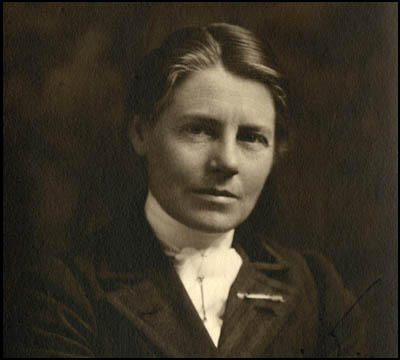
On this day in 1887 Winifred Batho, the daughter of Arthur John Batho, a postal telegraph clerk, was born in Sheffield on 9th August 1887. Her parents were members of the Wicker Congregational Church. Her father sailed to South Africa on the SS Durban in 1890 hoping to cure his tuberculosis, but, shortly after being joined by his family, he died and was buried in May 1891.
Batho returned to England and in 1907 she enrolled at the Sheffield School of Art. Batho joined the Women's Social and Political Union and disrupted a speech by Winston Churchill in 1909 by shouting "votes for women".
On 11th August 1911 she married Frank Horrabin, and in the same year he moved to London to work on the Daily News where he created the cartoon character of Japhet Noah. The couple were both socialists and became members of the Fabian Society and the Plebs' League. In 1912 Batho published a paper in which she argued that only the destruction of private property would release women from economic slavery. Batho became a Guild Socialist in 1915 and wrote a play, Victorian Love Story: Beloved Good, about Thomas Carlyle and his wife, Jane.
In 1920 Batho became a founder member of the Communist Party of Great Britain. Other early members included Tom Bell, Willie Paul, Arthur McManus, Frank Horrabin, Harry Pollitt, Rajani Palme Dutt, Helen Crawfurd, A. J. Cook, Albert Inkpin, J. T. Murphy, Arthur Horner, Tom Mann, John R. Campbell, Bob Stewart, Shapurji Saklatvala, William Mellor, George Aitken, Sylvia Pankhurst and Robin Page Arnot.
Winifred Batho became a follower of Stafford Cripps, the leader of the left-wing of the Labour Party. Other members of this group included Aneurin Bevan, Frank Wise, Frank Horrabin, Jennie Lee, Harold Laski, William Mellor, Barbara Betts and G. D. H. Cole. In 1932 the group established the Socialist League. During this period her husband began an extramarital affair with Ellen Wilkinson.
With the rise of Adolf Hitler in Nazi Germany, Batho became convinced that the Labour Party should establish a United Front against fascism with the Communist Party of Great Britain and the Independent Labour Party. In April 1934 William Mellor had a meeting with Fenner Brockway and Jimmy Maxton, two leaders of the ILP, "to talk over ways and means of securing working-class unity". He also had meetings with Harry Pollitt, the General Secretary of the Communist Party of Great Britain.
In January 1937 Stafford Cripps and George Strauss decided to launch a radical weekly, The Tribune, to "advocate a vigorous socialism and demand active resistance to Fascism at home and abroad." Mellor was appointed editor and others such as Barbara Betts, Aneurin Bevan, Ellen Wilkinson, Harold Laski, Michael Foot and Noel Brailsford agreed to write for the paper. Batho reviewed films and books for the journal.
William Mellor wrote in the first issue: "It is capitalism that has caused the world depression. It is capitalism that has created the vast army of the unemployed. It is capitalism that has created the distressed areas... It is capitalism that divides our people into the two nations of rich and poor. Either we must defeat capitalism or we shall be destroyed by it." Stafford Cripps wrote encouragingly after the first issue: "I have read the Tribune, every line of it (including the advertisements!) as objectively as I can and I must congratulate you upon a very first-rate production.''
Winifred Batho also wrote for Time and Tide. She had a weekly column in the Manchester Evening News under the nom de plume of Freda Wynne. She underwent a hysterectomy in February 1939. During this period Frank Horrabin began an extramarital affair with Margaret Victoria McWilliams. On 13th October 1947 the marriage was dissolved. Horrabin lived and worked for six months in Jamaica before moving to Blackheath in 1950.
Batho's biographer, Amanda L. Capern, wrote: "Her final years were marred by loneliness and a deep sense of failure. In 1951 her elder brother, Arthur (Artie) Denton Batho, died, leaving her without family, and she never fully recovered from the dissolution of her marriage."
Winifred Batho died at her home, Sandycross, Ridgeway Road, Dorking, Surrey, on 24th June 1971.
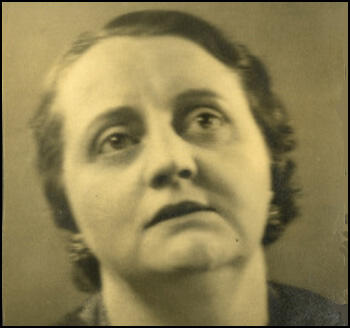
On this day in 1909 Adam von Trott zu Solz, the fifth child of the Prussian Culture Minister August von Trott zu Solz, was born in Potsdam, Germany on 9th August 1909. When his father resigned from office in 1917, the family moved to Kassel where von Trott attended the Friedrichsgymnasium. From 1922 he lived in Hann. He obtained his Abitur degree in 1927 and went on to study law at the universities of Munich and Göttingen. In 1931 he went to Mansfield College at Oxford University.
In 1934 he began to practice law in Kassel. In 1937 he was employed by the American Institute of Pacific Relations on a project in China. In October 1938 Trott went to Washington to inform his friends there of the German Resistance.
Trott believed that Neville Chamberlain should make it clear to Adolf Hitler that the appeasement policy was going to end. On 1st June, 1939, he arrived in London to have talks with British officials, including Edward Wood (Lord Halifax) and Philip Henry Kerr (Lord Lothian). According to Peter Hoffmann: At this time Trott was wondering whether he should leave Germany for the duration of the Nazi regime which he loathed, or whether he could fight the regime in some way."
On the outbreak of the Second World War he went to work for the Foreign Office. He joined the Nazi Party as a cover for his resistance activities. Trott married Clarita Tiefenbacher in June 1940. The daughter of a prominent Hamburg lawyer she met him when they were working China. Clarita fully supported his resistance activities. Trott wrote during this period he became a rebel because "the divine destiny of man has been trampled down into the dust" and set his hopes on "the sense of decency of the individual citizen."
In 1940 Trott, Peter Graf Yorck von Wartenburg and Helmuth von Moltke joined forces to establish the Kreisau Circle, a small group of intellectuals who were ideologically opposed fascism. Other people who joined included Fritz-Dietlof von der Schulenburg, Wilhelm Leuschner, Julius Leber, Adolf Reichwein, Carlo Mierendorff, Alfred Delp, Eugen Gerstenmaier, Freya von Moltke, Theodor Haubach, Marion Yorck von Wartenburg, Ulrich-Wilhelm Graf von Schwerin, Dietrich Bonhoffer, Harald Poelchau and Jakob Kaiser. "Rather than a group of conspirators, these men were more of a discussion group looking for an exchange of ideas on the sort of Germany would arise from the detritus of the Third Reich, which they confidently expected ultimately to fail."
The group represented a broad spectrum of social, political, and economic views, they were best described as Christian and Socialist. A. J. Ryder has pointed out that the Kreisau Circle "brought together a fascinating collection of gifted men from the most diverse backgrounds: noblemen, officers, lawyers, socialists, trade unionists, churchmen." (6) Joachim Fest argues that the "strong religious leanings" of this group, together with its ability to attract "devoted but undogmatic socialists," but has been described as its "most striking characteristic."
Members of the group came mainly from the young landowning aristocracy, the Foreign Office, the Civil Service, the outlawed Social Democratic Party and the Church. "There were perhaps twenty core members of the circle, and they were all relatively young men. Half were under thirty-six and only two were over fifty. The young landowning aristocrats had left-wing ideals and sympathies and created a welcome haven for leading Social Democrats who had elected to stay like the journalist-turned-politician Carlo Mierendorff, and... Julius Leber, were the political leaders of the group, and their ideas struck lively sparks off older members of the Resistance like Goerdeler."
The group disagreed about several different issues. Whereas Peter Graf Yorck von Wartenburg and Helmuth von Moltke were strongly anti-racist, others such as Fritz-Dietlof von der Schulenburg, believed that Jews should be eliminated from public service and evinced unmistakably anti-Semitic prejudice. "As late as 1938 he repeated his call for the removal of Jews from government and the civil service. His biographer, Albert Krebs, attests that he 'was never able to rid himself of feelings of alienation toward the intellectual and material world of Jewry.' He was appalled to learn of the crimes perpetrated against the Jewish population in the occupied Soviet Union, but this was not a major factor in his determination to see Hitler removed."
Peter Hoffmann, the author of The History of German Resistance (1977) has argued that one of strengths of the Kreisau Circle was that it had no established leader: "It consisted of of highly independent personalities holding views of their own. They were both able and willing to compromise, for they knew that politics without compromise was impossible. In the discussion phase, however, they clung to their own views." Although the Kreisau Circle did not have a leader, Peter Graf Yorck von Wartenburg and Helmuth von Moltke were the two most important figures in the group. Joachim Fest, the author of Plotting Hitler's Death (1997) has pointed out the Moltke has been described as the "engine" of the group, Wartenburg was its "heart".
Adam von Trott zu Solz became a very important member of the group. During the first winter of the war he began to think about the long-time future of Europe. He suggested that a European tariff and currency union, the setting up of a European Supreme Court and single European citizenship, as the basis for a future administrative unification of Europe. Moltke agreed and called for the setting up of a "supreme European legislature", which would be answerable, not to the national self-governing bodies, but to the individual citizens, by whom it would be elected. In other words, an European Parliament.
Helmuth von Moltke agreed with Trott and expressed the expectation that "a great economic community would emerge from the demobilization of armed forces in Europe" and that it would be "managed by an internal European economic bureaucracy". Combined with this he hoped to see Europe divided up into self-governing territories of comparable size, which would break away from the principle of the nation-state. Although their domestic constitutions would be quite different from each other, he hoped that by the encouragement of "small communities" they would assume public duties. His idea was of a European community built up from below.
Adam von Trott also made several attempts to negotiate with the British government. In May 1942 along with Moltke he arranged for Dietrich Bonhoeffer, a member of the Kreisau Circle, and Hans Schönfeld, a fellow clergyman, to meet Bishop George Bell in Stockholm. Bonhoeffer and Schönfeld asked Bell: "Would the Allies adopt a different stance toward a Germany that had liberated itself from Hitler than they would toward a Germany still under his rule? Bell reported back to the British Foreign Office, but Anthony Eden wrote back only to say he was "satisfied that it is not in the national interest to provide an answer of any kind." A few months later, Bell approached the British Foreign Office again, Eden noted in the margin of his reply, "I see no reason whatsoever to encourage this pestilent priest!"
The following year Helmuth von Moltke went to Stockholm with the latest leaflets being distributed by the White Rose resistance group. Adam von Trott and Eugen Gerstenmaier also went to the city to try and negotiate with representatives of the British government. Trott told them: "We cannot afford to wait any longer. We are so weak that we will only achieve our goal if everything goes our way and we get outside help." However, they received no encouragement. "The Allies did not even trouble themselves to reject the various attempts to contact them; they simply closed their eyes to the German resistance, acting as if it did not exist."
On 8th January, 1943, a group of conspirators, including, Adam von Trott, Helmuth von Moltke, Fritz-Dietlof von der Schulenburg, Johannes Popitz, Ulrich Hassell, Eugen Gerstenmaier, Ludwig Beck and Carl Goerdeler met at the home of Peter Graf Yorck von Wartenburg. Hassell was uneasy with the utopianism of the of the Kreisau Circle, but believed that the "different resistance groups should not waste their strength nursing differences when they were in such extreme danger". Wartenburg, Moltke and Hassell were all concerned by the suggestion that Goerdeler should become Chancellor if Hitler was overthrown as they feared that he could become a Alexander Kerensky type leader.
Claus von Stauffenberg decided to carry out the assassination of Adolf Hitler. But before he took action he wanted to make sure he agreed with the type of government that would come into being. Conservatives such as Carl Goerdeler and Johannes Popitz wanted Field Marshal Erwin von Witzleben to become the new Chancellor. However, socialists in the group, such as Julius Leber and Wilhelm Leuschner, argued this would therefore become a military dictatorship. At a meeting on 15th May 1944, they had a strong disagreement over the future of a post-Hitler Germany.
Stauffenberg was highly critical of the conservatives led by Carl Goerdeler and was much closer to the socialist wing of the conspiracy around Julius Leber. Goerdeler later recalled: "Stauffenberg revealed himself as a cranky, obstinate fellow who wanted to play politics. I had many a row with him, but greatly esteemed him. He wanted to steer a dubious political course with the left-wing Socialists and the Communists, and gave me a bad time with his overwhelming egotism."
The conspirators eventually agreed who would be members of the government. Head of State: Colonel-General Ludwig Beck, Chancellor: Carl Goerdeler; Vice Chancellor: Wilhelm Leuschner; State Secretary: Peter Graf Yorck von Wartenburg; State Secretary: Ulrich-Wilhelm Graf von Schwerin; Foreign Minister: Ulrich Hassell; Minister of the Interior: Julius Leber; State Secretary: Lieutenant Fritz-Dietlof von der Schulenburg; Chief of Police: General-Major Henning von Tresckow; Minister of Finance: Johannes Popitz; President of Reich Court: General-Major Hans Oster; Minister of War: Erich Hoepner; State Secretary of War: General Friedrich Olbricht; Minister of Propaganda: Carlo Mierendorff; Commander in Chief of Wehrmacht: Field Marshal Erwin von Witzleben; Minister of Justice: Josef Wirmer.
On 22nd July, 1944, Julius Leber and Adolf Reichwein met with two members of the underground Central Committee of the German Communist Party (KPD). "The meeting place was the house of a Berlin doctor, Rudolf Schmid... It was agreed that no names would be given and no introductions made; one of the communists who knew Leber, however, exclaimed:'Oh you, Leber.' Two of the visitors were in fact communist party functionaries, Anton Saefkow and Franz Jacob." In fact, a third communist turned up to the meeting. He was Hermann Rambow, who was in fact a Gestapo agent. The following day, Leber, Reichwein, Saefkow and Jacob were arrested.
On 20th July, 1944, Stauffenberg entered the wooden briefing hut, twenty-four senior officers were in assembled around a huge map table on two heavy oak supports. Stauffenberg had to elbow his way forward a little in order to get near enough to the table and he had to place the briefcase so that it was in no one's way. Despite all his efforts, however, he could only get to the right-hand corner of the table. After a few minutes, Stauffenberg excused himself, saying that he had to take a telephone call from Berlin. There was continual coming and going during the briefing conferences and this did not raise any suspicions.
Stauffenberg went straight to a building about 200 hundred yards away consisting of bunkers and reinforced huts. Shortly afterwards, according to eyewitnesses: "A deafening crack shattered the midday quiet, and a bluish-yellow flame rocketed skyward... and a dark plume of smoke rose and hung in the air over the wreckage of the briefing barracks. Shards of glass, wood, and fiberboard swirled about, and scorched pieces of paper and insulation rained down."
Stauffenberg observed a body covered with Hitler's cloak being carried out of the briefing hut on a stretcher and assumed he had been killed. He got into a car but luckily the alarm had not yet been given when they reached Guard Post 1. The Lieutenant in charge, who had heard the blast, stopped the car and asked to see their papers. Stauffenberg who was given immediate respect with his mutilations suffered on the front-line and his aristocratic commanding exterior; said he must go to the airfield at once. After a short pause the Lieutenant let the car go.
According to eyewitness testimony and a subsequent investigation by the Gestapo, Stauffenberg's briefcase containing the bomb had been moved farther under the conference table in the last seconds before the explosion in order to provide additional room for the participants around the table. Consequently, the table acted as a partial shield, protecting Hitler from the full force of the blast, sparing him from serious injury of death. The stenographer Heinz Berger, died that afternoon, and three others, General Rudolf Schmundt, General Günther Korten, and Colonel Heinz Brandt did not recover from their wounds. Hitler's right arm was badly injured but he survived.
However, General Erich Fellgiebel, Chief of Army Communications, sent a message to General Friedrich Olbricht to say that Hitler had survived the blast. The most calamitous flaw in Operation Valkyrie was the failure to consider the possibility that Hitler might survive the bomb attack. Olbricht told Hans Gisevius, they decided it was best to wait and to do nothing, to behave "routinely" and to follow their everyday habits. Major Albrecht Metz von Quirnheim long closely involved in the plot, had already begun the action with a cabled message to regional military commanders, beginning with the words: "The Führer, Adolf Hitler, is dead." As a result, Peter Graf Yorck von Wartenburg, Ludwig Beck, Eugen Gerstenmaier, and Fritz-Dietlof von der Schulenburg arrived at army headquarters in order to become members of the new government.
Adolf Hitler had survived the blast. He was seized by a "titanic fury and an unquenchable thirst for revenge" ordered Heinrich Himmler and Ernst Kaltenbrunner to arrest "every last person who had dared to plot against him". Hitler laid down the procedure for killing them: "This time the criminals will be given short shrift. No military tribunals. We'll hail them before the People's Court. No long speeches from them. The court will act with lightning speed. And two hours after the sentence it will be carried out. By hanging - without mercy."
Adam von Trott was arrested and tortured. His trial took place in front of by Roland Freisler on 15th August, 1944. Joseph Goebbels ordered that every minute of the trial should be filmed so that the movie could be shown to the troops and the civilian public as an example of what happened to traitors. He was found guilty but his execution of the death sentence was postponed in order to extract further information: "Since Trott has undoubtedly withheld a great deal, the death sentence pronounced by the People's Court has not been carried out so that Trott may be available for further clarification." Adam von Trott zu Solz was executed at Ploetzwnsee Prison on 25th August, 1944.
It is estimated that 4,980 people were arrested by the Gestapo. Heinrich Himmler gave instructions that these men should be tortured. He also ordered that family members should also be punished: "When they (the people's Germanic forbears) put a family under the ban and declared it outlawed or when there was a vendetta in the family, they were totally consistent about it. If the family was outlawed or banned; it will be exterminated. And in a vendetta they exterminated the entire clan down to its last member. The Stauffenberg family will be exterminated down to its last member."
What became known as the Sippenhaft law (criminal liability of the next of kin to a person considered a criminal) was a particularly sophisticated form of torture. When interrogating suspects the Gestapo could, quite legally, threaten to ill-treat their wives, children, parents, brothers and sisters or other relatives. Under this law, Clarita Tiefenbacher was placed in custody in the Moabit prison in Berlin while her two daughters, aged respectively 2 years and nine months, were interned under false names in the SS-run children's home of Bornheim in Bad Sachsa.
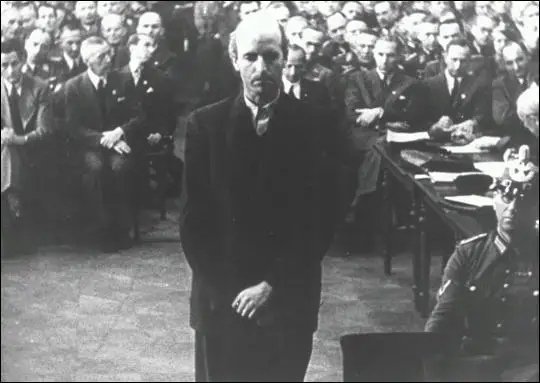
On this day in 1912 the Freeman's Journal makes an attack on Mary Leigh and Mabel Capper of the Women's Social and Political Union.
"Mary Leigh and Mabel Capper have long been among the most reckless members of the suffragist movement. They were two of a large band who visited Birmingham in September, 1909, and were arrested with others on charge arising out of a desperate and well-organised attempt to storm Bingley Hall where Mr Asquith was speaking to an audience of ten thousand. Leigh and another, eluding the vigilance of the police, climbed on to the roof of an adjoining factory, from which she threw ginger beer bottles, slates, and other missiles on the glass roof of Bingley Hall, and into the street when the Premier was passing in a motor car. While awaiting his appearance the women amused themselves by throwing projectiles at the crowd in the street and the police, several officers being struck. A policeman who climbed on the roof - a hazardous undertaking - found Leigh with her boots off, jumping about like a cat, as he described it, and armed with an axe used for the purpose of ripping slates from the roof: 'Come on up at your peril,' the women shouted to the officers, who were struck several times before effecting an arrest."
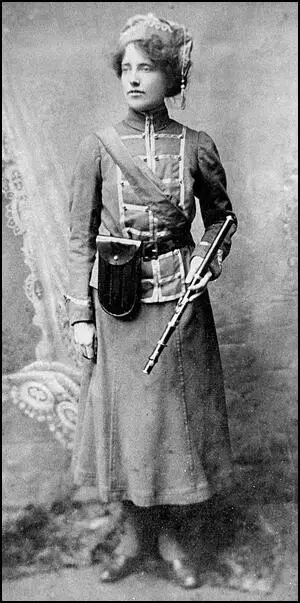
On this day in 1918 Lenin sends out orders to his subordinates Lenin made it clear that he expected the rigorous imposition of the Red Terror. In one order he told the chairman of the Council of People's Commissars that: "We must carry out a ruthless mass terror against the kulaks, priests and White Guards. All suspicious persons should be detained in a concentration camp outside the city."
Poster, "Bolshevik Freedom" blaming Leon Trotsky for the Red Terror (1919)
On this day in 1941 Douglas Bader is shot down over France. When William Sholto Douglas became head of Fighter Command, he developed what became known as the Big Wing strategy. This involved large formations of fighter aircraft deployed in mass sweeps against the Luftwaffe over the English Channel and northern Europe. Although RAF pilots were able to bring down a large number of German aircraft, critics claimed that they were not always available during emergencies and prime targets became more vulnerable to bombing attacks.
This strategy suited Bader and during the summer of 1941 he obtained 12 kills. His 23 victories made him the fifth highest ace in the RAF. However, on 9th August 1941, he suffered a mid-air collision down near Le Touquet, France. He parachuted to the ground but both his artificial legs were badly damaged.
Bader was taken to a hospital and with the help of a French nurse managed to escape. He reached the home of a local farmer but was soon arrested and sent to a prison camp. After several attempts to escape he was sent to Colditz.
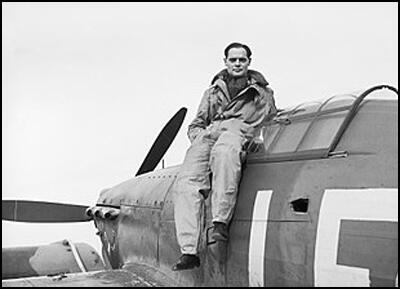
On this day in 1942 Raymond Postgate publishes an article in Tribune about Tom Wintringham.
"Readers should know Tom Wintringham's work: if they do not, they have missed the foremost military expert in the world. I wonder if that phrase isn't a little gross? Never mind, let it stand. It is because he is the only socialist who has paid attention to the theory and practice of war. He is not a pundit: he does not work through the usual channels. His education of his fellow citizens has been carried out strictly democratically and by writings addressed to the public. Major-Generals have had to go out and buy Picture Post. Although the political deductions Tom has drawn made scarlet majors turn purple, the technical truth and importance of what he said is so great they had to read on, and in the end their blood pressure went down."
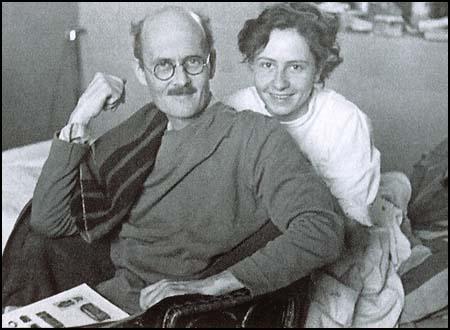
On this day in 1945 an atom bomb is dropped on Nagasaki. In 1942 the Manhattan Engineer Project was set up in the United States under the command of Brigadier General Leslie Groves. Scientists recruited to produce an atom bomb included Robert Oppenheimer (USA), David Bohm (USA), Leo Szilard (Hungary), Eugene Wigner (Hungary), Rudolf Peierls (Germany), Otto Frisch (Germany), Niels Bohr (Denmark), Felix Bloch (Switzerland), James Franck (Germany), James Chadwick (Britain), Emilio Segre (Italy), Enrico Fermi (Italy), Klaus Fuchs (Germany) and Edward Teller (Hungary).
Winston Churchill and Franklin D. Roosevelt were deeply concerned about the possibility that Germany would produce the atom bomb before the allies. At a conference held in Quebec in August, 1943, it was decided to try and disrupt the German nuclear programme. In February 1943, SOE saboteurs successfully planted a bomb in the Rjukan nitrates factory in Norway. As soon as it was rebuilt it was destroyed by 150 US bombers in November, 1943. Two months later the Norwegian resistance managed to sink a German boat carrying vital supplies for its nuclear programme.
Meanwhile the scientists working on the Manhattan Project were developing atom bombs using uranium and plutonium. The first three completed bombs were successfully tested at Alamogordo, New Mexico on 16th July, 1945. James Chadwick later described what he saw during the test: "An intense pinpoint of light which grew rapidly to a great ball. Looking sideways, I could see that the hills and desert around us were bathed in radiance, as if the sun had been turned on by a switch. The light began to diminish but, peeping round my dark glass, the ball of fire was still blindingly bright ... The ball had then turned through orange to red and was surrounded by a purple luminosity. It was connected to the ground by a short grey stem, resembling a mushroom."
By the time the atom bomb was ready to be used Germany had surrendered. James Franck and Leo Szilard drafted a petition signed by just under 70 scientists opposed to the use of the bomb on moral grounds. Franck pointed out in his letter to Truman: "The military advantages and the saving of American lives achieved by the sudden use of atomic bombs against Japan may be outweighed by the ensuing loss of confidence and by a wave of horror and repulsion sweeping over the rest of the world and perhaps even dividing public opinion at home. From this point of view, a demonstration of the new weapon might best be made, before the yes of representatives of all the United Nations, on the desert or a barren island. The best possible atmosphere for the achievement of an international agreement could be achieved if America could say to the world, "You see what sort of a weapon we had but did not use. We are ready to renounce its use in the future if other nations join us-in this renunciation and agree to the establishment of an efficient international control."
However, the advice of the scientists was ignored by Harry S. Truman, the USA's new president, and he decided to use the bomb on Japan. General Dwight Eisenhower agreed with the scientists: "I voiced to him my grave misgivings, first on the basis of my belief that Japan was already defeated and that dropping the bomb was completely unnecessary, and secondly because I thought that our country should avoid shocking world opinion by the use of a weapon whose employment was, I thought, no longer mandatory as a measure to save American lives. It was my belief that Japan was, at that very moment, seeking some way to surrender with a minimum loss of face."
At Yalta, the Allies had attempted to persuade Joseph Stalin to join in the war with Japan. By the time the Potsdam meeting took place, they were having doubts about this strategy. Winston Churchill in particular, were afraid that Soviet involvement would lead to an increase in their influence over countries in the Far East. On 17th July 1945 Stalin announced that he intended to enter the war against Japan.
President Truman now insisted that the bomb should be used before the Red Army joined the war against Japan. Leslie Groves, the head of the Manhattan Project, wanted the target to be Kyoto because as it had been untouched during previous attacks, the dropping of the atom bomb on it would show the destructive power of the new weapon. However, the Secretary of War, Henry Stimson, argued strongly against this as Kyoto was Japan's ancient capital, a city of immense religious, historical and cultural significance. General Henry Arnold supported Stimson and Truman eventually backed down on this issue.
President Truman wrote in his journal on 25th July, 1945: "This weapon is to be used against Japan between now and August 10th. I have told the Secretary of War, Mr Stimson, to use it so that military objectives and soldiers and sailors are the target and not women and children. Even if the Japs are savages, ruthless, merciless and fanatic, we, as leader of the world for the common welfare cannot drop this terrible bomb on the old capital or the new. He & I are in accord. The target will be a purely military."
Truman's military advisers accepted that Kyoto would not be targeted but insisted that another built-up area should be chosen instead: "While the bombs should not concentrate on civilian areas, they should seek to make a profound a psychological impression as possible. The most desirable target would be a vital war plant employing a large number of workers and closely surrounded by workers' houses."
Winston Churchill insisted that two British representives should witness the dropping of the atom bomb. Squadron Leader Leonard Cheshire and William Penny, a scientist working on the Manhattan Project, were chosen for this task. Churchill ordered them to learn "about the taqctical aspects of using such a weapon, reach a conclusion about its future implications for air warfare and report back to the Prime Minister."
General Thomas Farrell, Commander of the Manhattan Project, explained to Cheshire and Penny that they had produced two types of bomb. Fat Man relied upon implosion: a 12 lb sphere of plutonium would be abruptly squeezed to super-critically by the detonation of an envelope of explosive. Little Boy functioned by a gun mechanism which fired two subcritical masses of uranium 235 together.
President Harry S. Truman eventually decided that the bomb should be dropped on Hiroshima. It was the largest city in the Japanese homeland (except Kyoto) which remained undamaged, and a place of military industry. However, Truman, after listening from advice of General Curtis LeMay, refused permission for Leonard Cheshire and William Penny to witness the event. Leslie Groves, according to Cheshire, "said firmly that there was no room for either of us; in any case he couldn't see why we needed to be there, for we would receive a full written report and could ask to see any documentation we wanted."
On 6th August 1945, a B29 bomber piloted by Paul Tibbets, dropped an atom bomb on Hiroshima. Michihiko Hachiya was living in the city at the time: "Hundreds of people who were trying to escape to the hills passed our house. The sight of them was almost unbearable. Their faces and hands were burnt and swollen; and great sheets of skin had peeled away from their tissues to hang down like rags or a scarecrow. They moved like a line of ants. All through the night, they went past our house, but this morning they stopped. I found them lying so thick on both sides of the road that it was impossible to pass without stepping on them."
Later that day President Harry S. Truman made a speech where he argued: "The harnessing of the basic power of the universe. The force from which the sun draws its power has been used against those who brought war to the Far East. We have spent $2,000,000,000 (about $500,000,000) on the greatest gamble in history, and we have won. With this bomb we have now added a new and revolutionary increase in destruction to supplement the growing power of our armed forces. In their present form these bombs are now in production and even more powerful forms are in development."
Truman then issued a warning to the Japanese government: "We are now prepared to obliterate more rapidly and completely every productive enterprise the Japanese have above ground in any city. We shall destroy their docks, their factories and their communications. Let there be no mistake, we shall completely destroy Japan's power to make war. It was to spare the Japanese people from utter destruction that the ultimatum of July 26 was issued from Potsdam. Their leaders promptly rejected that ultimatum. If they do not now accept our terms they may expect a rain of run from the air the like of which has never been seen on this earth. Behind this air attack will follow sea and land forces in such numbers and power as they have not yet seen and with a fighting skill of which they have already become well aware."
Hideki Tojo, Japan's Foreign Minister, told Emperor Hirohito on 8th August, 1945, that Hiroshima had been obliterated by an atom bomb and advised surrender. Others raised doubts about whether the United States had more than one of these bombs. The Supreme Council decided to convene a meeting on the morning of 9th August. As they had not immediately surrendered President Truman ordered that a second atom bomb should be dropped on Japan.
Major Charles Sweeney was selected to lead the mission and Nagasaki was chosen as the target. This time it was agreed that Leonard Cheshire and William Penny, could travel on the aircraft that was to take photographs of the attack on 9th August. When they reached Nagasaki they found the city covered in cloud and Kermit Beahan, the bombardier, was at first unable to find the target. Eventually, the cloud parted and Beahan dropped the bomb a mile and a half from the intended aiming point.
William Laurence was a journalist who was invited by Leslie Groves to be on Sweeney's aircraft: "We watched a giant pillar of purple fire, 10,000 feet high, shoot up like a meteor coming from the earth instead of outer space. It was no longer smoke, or dust, or even a cloud of fire. It was a living thing, a new species of being, born before our incredulous eyes. Even as we watched, a ground mushroom came shooting out of the top to 45,000 feet, a mushroom top that was even more alive than the pillar, seething and boiling in a white fury of creamy foam, a thousand geysers rolled into one. It kept struggling in elemental fury, like a creature in the act of breaking the bonds that held it down. When we last saw it, it had changed into a flower-like form, its giant petals curving downwards, creamy-white outside, rose-coloured inside. The boiling pillar had become a giant mountain of jumbled rainbows. Much living substance had gone into those rainbows."
Leonard Cheshire later recalled in his book, The Light of Many Suns (1985): "The ultra-dark glasses we each had round our foreheads to protect our eyes from the blinding light of the bomb were not needed because we were about fifty miles away. By the time I saw it, the flash had turned into a vast fire-ball which slowly became dense smoke, 2,000 feet above the ground, half a mile in diameter and rocketing upwards at the rate of something like 20,000 feet a minute. I was overcome, not by its size, nor by its speed of ascent but by what appeared to me its perfect and faultless symmetry. In this it was unique, above every explosion that I had ever heard of or seen, the more frightening because it gave the impression of having its immense power under full and deadly control.... The cloud lifted itself to 60,000 feet where it remained stationary, a good two miles in diameter, sulphurous and boiling. Beneath it, stretching right down to the ground was a revolving column of yellow smoke, fanning out at the bottom to a dark pyramid, wider at its base than was the cloud at its climax. The darkness of the pyramid was due to dirt and dust which one could see being sucked up by the heat. All around it, extending perhaps another mile, were springing up a mass of separate fires. I wondered what could have caused them all."
Fumiko Miura was a 16 year-old girl working in Nagasaki at the time: "I was doing some clerical work for the Japanese imperial army. At about 11 o'clock, I thought I heard the throbs of a B-29 circling over the two-storey army headquarters building. I wondered why an American bomber was flying around above us when we had been given the all-clear.... At that moment, a horrible flash, thousands of times as powerful as lightning, hit me. I felt that it almost rooted out my eyes. Thinking that a huge bomb had exploded above our building, I jumped up from my seat and was hit by a tremendous wind, which smashed down windows, doors, ceilings and walls, and shook the whole building. I remember trying to run for the stairs before being knocked to the floor and losing consciousness. It was a hot blast, carrying splinters of glass and concrete debris. But it did not have that burning heat of the hypocentre, where everyone and everything was melted in an instant by the heat flash. I learned later that the heat decreased with distance. I was 2,800m away from the hypocentre."
After a long debate Emperor Hirohito intervened and said he could no longer bear to see his people suffer in this way. On 15th August the people of Japan heard the Emperor's voice for the first time when he announced the unconditional surrender and the end of the war. Naruhiko Higashikuni was appointed as head of the surrender government.
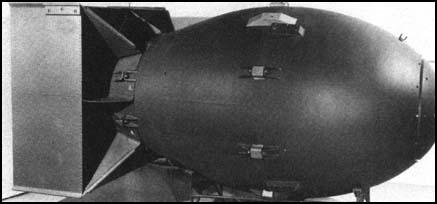
On this day in 1947 Gerhart Eisler went on trial. Gerhart Eisler "took the stand, dressed in his shapeless gray suit and blue shirt with its too-large collar." (32) Eisler argued: "I never in my life was a member of the Communist International. I never in my life went anyplace in the whole world as a representative of the Comintern." Eisler denied he was a member of a group that advocated the overthrow of the United States government. He was a member of the German Communist Party (KPD) and this was not one of its policies.
After only a few hours of deliberation, the jury brought in a guilty verdict and he was sentenced to a year in prison. Robert J. Lamphere asked Eisler as the court was adjourning, "Gerhart, do you think you got a fair trial?" He replied: "Yes, a fair trial but an unfair indictment. Lamphere later recalled: "It was the last time I saw Eisler in person; in a way, I almost liked him - his bravado was astonishing."
The government asked for $100,000 bail, the judge set bail at $23,500. This was put up by supporters of the Communist Party of the United States and Eisler was freed pending appeal. He was tailed by the FBI but in May 1949 he managed to stowaway on the Polish ship Batory. According to Time Magazine, Eisler's lawyer, Carol Weiss King, "almost exploded" when she heard that Eisner had jumped bail, causing the confiscation of the money raised by her friends.
The United States asked Great Britain to hold Eisler for extradition and he was arrested in Southampton. Eisler's British lawyers convinced the court that under British law a false oath was not perjury unless it had been taken in connection with a judicial proceeding. Eisler was released and he continued his journey to East Germany.
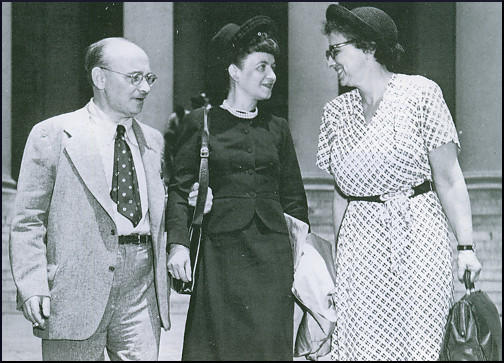
On this day in 1990 footballer and manager Joe Mercer died in Liverpool.
Joseph (Joe) Mercer, the son of Joseph Powell Mercer, who played for Nottingham Forest and Tranmere Rovers, was born in Ellesmere Port on 9th August 1914.
Mercer played football in the streets of Ellesmere Port: "Back alley football is only a substitute for the real thing. We always have to right for bigger and better playing fields for children. But, all the same, the back alleys did hold some valuable lessons of their own. For instance, playing with a small ball. If you could control a small hall with certainty, you found later that bringing down a normal ball came more easily. It was wonderful training for the eye."
Mercer and his friend, Stan Cullis, both played football forCambridge Road School. Both showed outstanding ability and were selected to play for Ellesmore Port Boys against Chester Boys in January 1929. Two years later Mercer signed for Everton.
Joe Mercer made his debut at wing-half in April 1933. The team at that time included Dixie Dean, Cliff Britton, Ted Sager, Albert Geldard, and Jack Jones.
In December, 1936, Everton signed Tommy Lawton for a fee of £6,500. It was a record fee for a teenager. One of the attractions of the deal was that Lawton now had the opportunity to play with Dixie Dean. When they met for the first-time, Dean put his arm round Lawton and said: "I know you've come here to take my place. Anything I can do to help you I will. I promise, anything at all." Dean was thirty years old and after suffering several serious injuries, he knew that there was not much time left for him at the top. Dean kept his promise and spent a lot of time with Lawton on the training field.
Six weeks after joining the club, Tommy Lawton was brought into the first team for an away match against Wolverhampton Wanderers, as Dixie Dean was rested prior to a fifth round FA Cup tie with Tottenham Hotspur. Lawton found it difficult playing against the England centre-half, Stan Cullis, however, he did score a goal 15 minutes from the end.
Everton drew the FA Cup tie with Tottenham Hotspur 1-1 and it was decided to play Tommy Lawton alongside Dixie Dean in the replay. In the second minute Lawton scored with a tremendous shot from outside the penalty area. Dean turned to Mercer and said: "Well, that's it then. That's the swan song. That's the end of it." Dean realised that it would not be long before this talented player took his place in the side.
At the beginning of the 1937-38 season Tommy Lawton played at inside-right and Dixie Dean at centre-forward. The pairing did not work and Everton failed to win a game when they two men played together. On 8th September 1937, Dean was dropped and Lawton replaced him as centre-forward to play against Manchester City. Lawton scored in the 4-1 victory and Dean only played in two more games for Everton before leaving the club.
Everton finished in 14th place in the 1937-38 season with Tommy Lawton ending up as the club's top marksman with 28 goals in 39 league games. He was also the top scorer in the whole of the First Division. This was an amazing achievement for someone who was only 18 years old.
Mercer, who was only 24 years old, had developed into a great player for Everton. Tony Matthews in Who's Who of Everton points out that Mercer "was an outstanding wing-half with a biting tackle and a never-say-die attitude." Mercer won his first international cap for England against Northern Ireland on 16th November 1938. The England team that day also included Eddie Hapgood, Stan Cullis, Willie Hall, Tommy Lawton and Stanley Matthews. England won the game 7-0.
In the 1938-39 season Everton won the First Division league title, by beating Wolverhampton Wanderers by four points. Tommy Lawton was the club's top marksmen with 34 goals in 38 games.
Joe Mercer won his fifth and last international cap for England against Romania on 16th November 1938. The England team that day also included Stan Cullis, Tommy Lawton, Frank Broome, Wilf Copping, Len Goulden and George Male. England won the game 2-0.
Tommy Lawton later commented: "Joe Mercer was a tremendous tackler, timing his interventions perfectly, and he loved nothing more than to bring the ball up and take part in an attack with his forwards. He had a deceptive speed, but then Joe was a deceptive player, probably due to those bandy legs of his."
The outbreak of the Second World War brought a halt to the Football League. The British Army invited some of the best footballers to became Physical Training instructors at Aldershot. This included Joe Mercer. Other top players at Aldershot included Wally Boyes, Cliff Britton, Matt Busby, Don Welsh, Billy Cook, Arthur Cunliffe, Archie Macaulay, Norman Corbett, Tommy Lawton, Bert Sproston and Eric Stephenson.
Mercer returned to Everton after the war and stayed at the club until being transferred to Arsenal for a fee of £8,000 in November 1946. It was an excellent signing. According to Jeff Harris, the author of Arsenal Who's Who (1995): "Joe Mercer was one of the most influential players Arsenal have ever had." At the time the club was at the bottom of the First Division.
Mercer was appointed captain of the side and led Arsenal to the 1947-48 league championship and the 1950 FA Cup victory over Liverpool. That year he was voted by the Football Writers' Association (FWA) as their Footballer of the Year Award. Mercer won his third championship medal when Arsenal finished the 1952-53 season beating Preston North End on goal average.
Len Shackleton argued he was convinced that "Joe Mercer, as an Arsenal player between his thirtieth and fortieth birthdays, was a far better wing-half than in his younger days as an Everton and England player. When Joe Mercer discovered his legs would not allow him to run all over the field, when his physical condition hampered him, when he played almost entirely in his own half of the field, he was great. The service of wonderful passes that flowed from this spindly bow-legged genius was, I am certain, fifty per cent of the reason for Arsenal's post-war successes."
On 10th April 1954 Mercer played in a league game again Liverpool. Tommy Lawton, who had recently joined Arsenal, later described how he heard the "sickening crack" when Mercer collided with Joe Wade. His right-leg was fractured in two places and he was forced to retire from playing football.
Mercer ran a grocery shop in the Wirral before becoming manager of Sheffield United in August 1955. He moved to Aston Villa and in 1960 helped the club win the Second Division title. He resigned in July 1964 and the following year he joined Manchester City. He appointed Malcolm Allison as his assistant in 1966 and over the next few years he had great success winning the Second Division (1967), First Division (1968), the FA Cup (1969), League Cup (1970) and European Cup-Winners Cup (1971). In 1974 Mercer was the temporary manager of the England national side.
